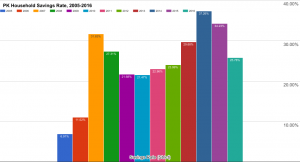Don't Quit Your Day Job... certainly mixes up the article categories, but at our heart we're a finance web site. Personal finance or otherwise, that means most of the prose on this website boils down to dollars and cents.
One of our annual traditions is to calculate and post our savings rate soon after tax-day. Your savings rate is one of the most important statistics you can track. With your net worth calculated and your savings rate tracked, you are able to estimate your retirement or financial independence date. (You know, after filling in a number of your own estimates and assumptions).
Historically, I've rolled up only a net savings rate counting contributions which were earmarked to savings. I've heard your complaints over the years - I've also rolled up a gross savings rate which also includes principal paydowns and the like for my wife and yours truly. Without further ado, the PK family savings rate(s) for 2016:
- Net savings rate: 25.78%
- Gross savings rate: 38.18%
2016: A Great Year With a Declining Savings Rate
2016 was an amazing year for us as a family - we had our second daughter! Our first has reached the age where she's now attending day care for the first time. The savings side wasn't so hot though - overall, our spending caused a 8.45% point drop year over year.
Using the strict net savings rate, the last year that was similar to 2016 was 2012:
That's a drop from 34.23% to 25.78% year over year, and two years in a row of declining rates. That's a trend we hope to stop in 2017!
Spelling out all the years I have the net number calculated, here they are in tabular form:
| Year | 2005 | 2006 | 2007 | 2008 |
| Savings Rate (Strict) | 6.91% | 11.02% | 31.63% | 27.31% |
| Year | 2009 | 2010 | 2011 | 2012 |
| Savings Rate (Strict) | 21.68% | 21.47% | 22.96% | 23.99% |
| Year | 2013 | 2014 | 2015 | 2016 |
| Savings Rate (Strict) | 29.68% | 37.26% | 34.23% | 25.78% |
On the gross side, we're going to be making those calculations going forward. We went from somewhere roughly in the low to mid 40%s to 38.18%. So, no, it wasn't a banner year when making calculations using that rate either - I believe there was still somewhere between a 3% and 6% drop by the gross measurement!
Reflections on Our Spending
We write these posts to keep ourselves honest as well as to hold ourselves accountable in a quasi-public forum. While hopefully you won't be dropping us from your weekly reads over a 8.45 percentage savings point drop, we do want to reflect on some of the increased spending.
While we would have spent down all our resources to have a healthy second daughter (an obvious non-negotiable!), we did start day care for our first. There's no getting around it: finding the right combination of quality and convenience in a day care is expensive here in the Bay Area. Even with DCAP savings (which don't come close to covering annual costs here, haha) day care ends up costing quite a bit.
Outside of family-related expenses, our food costs, transportation costs, and vacation costs increased as well. These are all areas we'll be making efforts to decrease in 2017 and beyond. (Of course, without sacrificing the healthy diet we've been eating!)
Looking Forward to Health and Savings in 2017
I wouldn't trade 2016 for the world - it was an incredible year for our family.
However, we've obviously got some things to work on just below the surface. Food costs are pretty much the top of our targeting savings list, so we hope to report out some better results on that front in next year's edition. We'll also be keeping an eye on some of the other categories as well.
Those are reasons though, not excuses - even with the costs of the Bay Area and an expanding family, we want to juice that savings rate in 2017. All in all though, from most perspectives we're still saving at a reasonable clip - would you allow us a B-/C+ on that rate for the year? (Ha!)
On the savings front, we're increasing the automatic savings to the 529s for both daughters. Outside of tax-advantaged accounts, we're saving more in non-tax advantaged vehicles - municipal bonds, stock, ETFs and the like.
Let us know what you think, and we'd love to hear how you did as well - drop your rates and experiences in the comments. Of course, if you have other investment and savings ideas for a California family, drop those in the comments as well - we appreciate all of your responses!

